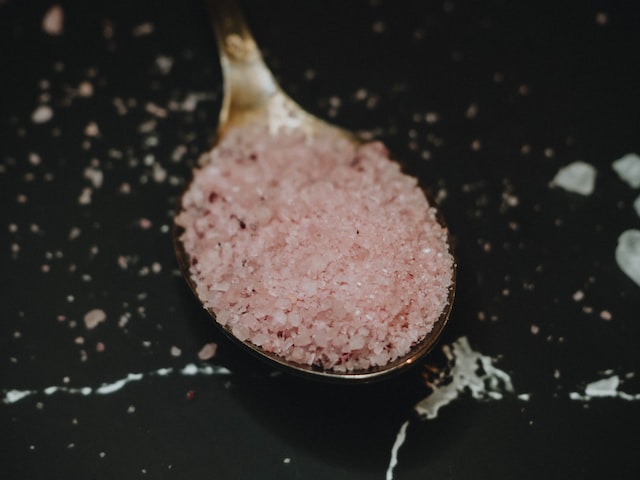In recent years, the natural health community rejected table salt in favour of Himalayan salt. Increasingly, you would find pink salt instead of white salt on their tables. There are several good reasons for this switch, the most important of which is that Himalayan salt is vastly nutritionally superior.
Mining and Processing Like everything else we eat in the 21st century, white table salt is industrially processed until it hardly at all resembles natural food. It is normally mined from salt mines or sea water that have been open to contamination for decades or centuries. To remove the "impurities" that detract from its perfect whiteness, it is dried at a temperature of around 600 degrees celsius and picked over with magnets and other filtering devices to remove metal, rock, and mineral contents. Salt in this form tends to cake, however, so it is then shipped to factories where anti-clumping chemicals are added. Iodine is also added to prevent iodine deficiency.
Most Himalayan salt on the other hand, is obtained from the Khewra Salt Mine in the Punjab region of Pakistan where lava, ice, and snow have protected it from contamination for centuries. It essentially contains no impurities that should be removed, which eliminates the need for excessive processing. It is usually hand washed, stone-ground, and no industrial chemicals are added.
Nutritional Value Once the processing of table salt is completed, the salt contains almost 99 per cent of sodium chloride, one per cent of anti-clumping chemicals, and a bit of iodine. All the healthy minerals that are a natural part of salt are missing.
Instead of simply being almost pure sodium chloride, Himalayan salt contains around 95 per cent of sodium chloride and five per cent of minerals, including calcium, magnesium, potassium, iron, chromium, zinc, manganese, cobalt, copper, nickel, and dozens of others.
The minerals come from two sources: firstly, they are in the salt rock in their natural forms and secondly, the sodium chloride is contaminated with polyhalite, which is essentially evaporate minerals like potassium, calcium, and magnesium. In other words, even the sodium chloride contains minerals.
Sea salt also contains some of these minerals, but many of them are removed during processing. Organic sea salt is normally obtained from areas that have been protected from contamination and the amount of industrial processing is kept to a minimum. Still, at this stage there are no laws that regulate the organic sea salt industry, so it is difficult to know where exactly it comes from and how it has been protected against contaminants, such as arsenic and heavy metals, that are common in seawater.
The Importance of Minerals
Iodine
Iodine is essential for proper thyroid functioning, metabolism, cognitive operations, and so forth. Food sources include eggs, dairy, and meat. When eating an alkaline diet, be sure that these items make up the 20% portion of the acidic foods permitted to keep your pH in check (slightly alkaline). It can also be found in kelp, which few people want to eat several times a week.
Table salt manufacturers add it to their products precisely because poor consumers in the developing world eat too few animal products for sufficient iodine intake. A better option than table salt, however, is to eat Himalayan salt and take an iodine supplement. Nascent Iodine is an iodine supplement that has been designed especially to mimic the iodine your thyroid produces, in a completely bioavailable form.
Calcium
Calcium is an extremely important mineral of which table salt deprives us due to its acidic nature. It helps to:
- develop and maintain strong bones and teeth,
- stabilise blood pressure,
- plays a definitive role in blood clotting,
- helps with cell-to-cell communication,
- assists your body in alkalising your blood,
- plays a role in normal brain function,
- and it helps your body absorb vitamin D (which is also essential to develop and maintain strong bones).
Magnesium
Magnesium is equally important. This mineral helps to:
- promotes the development and maintenance of strong bones and teeth,
- helps with muscle contractions,
- supports the heart muscle,
- is essential for normal nerve function,
- helps to regulate blood glucose levels,
- and it contributes to a healthy metabolism.
Potassium
Potassium helps your body:
- maintain a healthy alkalinity,
- is essential for proper fluid balance,
- promotes muscle contractions,
- contributes to normal nerve function,
- supports the development and maintenance of healthy bones and teeth,
- and it helps to regulate blood pressure.
Iron
Most of your body's iron is tied to haemoglobin in your red blood cells. Without iron, your bone marrow cannot make new red blood cells. With too few of these, you will be permanently physically and mentally exhausted. Iron is vital because it:
- transports oxygen through your body,
- it removes carbon dioxide from your body,
- contributes to the conversion of blood sugar to energy,
- helps to produce the enzymes that, in turn, produce new cells,
- and it is required for a healthy immune system.
More Water is Needed to Break Down Table Salt
While scientists have not been sufficiently interested in types of salt to study the differences officially, the natural health community believes strongly that your body uses more water to metabolise table salt than it uses to break down Himalayan salt. The latter absorbs water, as you will find out if you leave your jar open on your kitchen counter. Table salt, on the other hand, is made specifically to repel water to prevent it from becoming moist too quickly.
Accordingly, your body must pull water from its cells to dissolve and process table salt properly. This means that you must drink more water, but it also means that your body must hold onto water that it would otherwise be happy to excrete. An excess in body fluid contributes to cellulite, breathing difficulties, coughing, pressure on your heart, swollen legs and face, varicose veins, and many other unpleasant conditions.
Better Absorption of Key Minerals
Unlike that of heavily processed table salt, the crystalline structure of Himalayan salt is natural, with all its crystals connected with each other. This facilitates the absorption of the sodium chloride and important minerals often lacking in our diet. The unnatural, disconnected crystalline structure of table salt makes it difficult for your body to absorb.




























Leave a comment